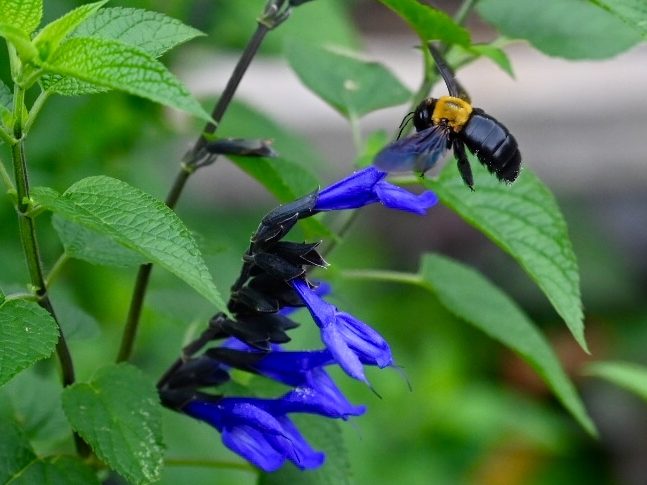Good morning!
We have fresh flowers at the altar, crisp cool fall air, and whispering waterfall sounds. Hibiscus is called the endless or limitless flower (mugenka), as it continues blooming year round in tropical zones, and it has become national, state flowers. It is also called the Buddha heart flower (bussoge), as its style looks like a Buddha standing in a lotus. Remembering his life, the Buddha uttered, “The world is sweet and beautiful!”
Ryokan made a poem of “butterflies and flowers”:
Flowers invite butterflies with no mind;
Butterflies visit flowers with no mind;
When flowers bloom, butterflies come;
When butterflies come, flowers bloom;
I do not know people, and
People do not know me, either;
Following the universal truth with no knowledge.
Dogen said, “When I love mountains, mountains love me.” When we love gardens, gardens love us. When we take care of gardens, gardens reveal their beauty, goodness, and truth. When we love flowers, flowers love us. When we offer flowers to the Buddha, flowers are with him and with us all, as bodhisattvas, to dedicate our thanks to the world of all life forms that have endowed and supported our life.
We’ve inherited plants’ photo sensors and developed it in different ways – human worlds are dominantly visual worlds, butterflies and birds can see flowers having nectar, while plants produce food and oxygen for us as well as for themselves. Neanderthals, sharing our ancestors, are said to have gone extinct due to cannibalism, consanguineous marriage, destruction by home sapiens, but they are actually living within us.
August 24, 2019C.E. Dharma speech
Note 1. Bussoge is usually written 仏桑花, lit. Buddha mulberry flower, but I remember seeing 仏懆花,lit. Buddha chastity flower, thus the interpretation given above. In the southern island of Okinawa, people plant this in the graveyard as 後生花 guso-bana, lit. afterlife flower, to pray the deceased finds peace and happiness.
- Offering flowers to the Buddha is considered an expression of one’s vow to patiently endure in practicing the Awakened Way (cf. patience, one of the six perfections), as flowers bloom in severe environments and even after they have been cut from them.
お早うございます!
祭壇には新鮮な花があり、爽やかな涼しい秋の空気に、囁くような滝の音があります。ハイビスカスは熱帯では一年中咲き続けるので、無限花と呼ばれ国花や州花に成っています。その花柱は仏陀が蓮の花の中に立つように見えるので仏懆花とも呼ばれています。仏陀は生涯を振り返り「世界は甘美だ!」と憶いをふと口にしています。
良寛は「蝶と花」の詩を作っています:
花無心招蝶 (花無心にして蝶を招き)
蝶無心尋花 (蝶無心にして花を尋ぬ)
花開時蝶来 (花開くとき蝶来たり)
蝶来時花開 (蝶来るとき花開く)
吾亦不知人 (吾もまた人を知らず)
人亦不知吾 (人もまた吾を知らず)
不知従帝側 (知らずして帝ののりに従ふ)
道元は「我山を愛す時山我を愛す」と言っています。私達が庭を愛す時には庭が私達を愛します。庭の手入れをする時、庭はその美善真を明かしてくれます。私達が花を愛す時、花は私達を愛します。私達が仏陀に花を供える時、花は彼とそして私達の命を恵み支えてくれた一切の命の形態を持つ世界に感謝をささげる私達全てと共にあります。
私達は植物の光感覚器を受け継ぎ異なる方法で発展させました―人間の世界は主として視覚世界であり、蝶や鳥は蜜を持つ花を見つけることが出来、一方植物は食料や酸素を自らと共に私達の為に産み出します。祖先を共有するネアンデルタール人は人肉食、近親婚、ホモサピエンス攻撃等で滅ぼされたと言われていますが、実は私達の中に生きているのです。
2019共通年8月24日 法話
註 1.ブッソウゲは通常仏桑花と書きますが、仏懆花と書いてあるのを見た憶えがありますので、上の解釈をしました。沖縄南部では後生花(グソウバナ)として死者の冥福を祈る為に墓に植えるそうです。
2.仏に供える仏花は厳しい環境に耐えて咲く花、また切られても咲き続けることから仏道修行の厳しさに耐えて咲く誓いを表すものとされています(忍耐は六波羅蜜の一つ)。
2019共通年8月24日 法話
The above pictures were taken and sent
by Mr. Noriyuki Otuka
from Shimoda, Shizuoka, Japan







